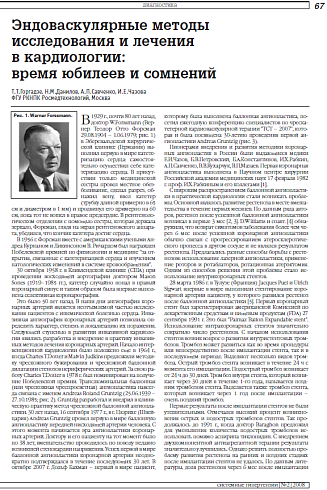Материалы доступны только для специалистов сферы здравоохранения.
Чтобы посмотреть материал полностью
Авторизуйтесь
или зарегистрируйтесь.
Эндоваскулярные методы исследования и лечения в кардиологии: время юбилеев и сомнений - Журнал Системные Гипертензии №2 (2008)
Эндоваскулярные методы исследования и лечения в кардиологии: время юбилеев и сомнений
Материалы доступны только для специалистов сферы здравоохранения.
Чтобы посмотреть материал полностью
Авторизуйтесь
или зарегистрируйтесь.
Полный текст
Список литературы
1. Бабунашвили А.М., Рабкин И.Х. Иванов В.А. Коронарная ангиопластика. М., 1996.
2. Serruys PW, Luijten HE, Beatt KJ et al. Incidence of restenosis after successful coronary angioplasty: a time related phenomenon. Circulation 1988; 77: 361–71.
3. Nobuyoshi M, Kimura T, Nosoka H et al. Restenosis after successful Percutaneous transluminal coronary angioplasty. Serial angiographic follow-up of 229 patients. J Am Coll Cardiol 1988; 12: 616–23.
4. Williams DO, Joelson JM, Most AS. Angiographic findings when chest pain recurs after successful percutaneous transluminal coronary angioplasty. Am J Cardiology 1987; 60: 792–5.
5. Meier B. Use and Abuse of Coronary Stenting. Hospital Chronicles 2006; Suppl.: 99–103.
6. Daemen J, Serruys PW. Drug-Eluting Stent Update 2007. Part I: A Survey of Current and Future Generation Drug-Eluting Stents: Meaningful Advances or More of the Same? Circulation 2007; 116: 316–28.
7. Camenzind E. ESC Congress News 2006, September.
8. Stone GW et al. New Engl J Med 2007; 356: 998–1008.
9. Lagerqvist B, James SK et al. Long-term outcomes with drug eluting stents versus bare-metal stents in Sweden. New Engl J Med 2007; 356: 1009–19.
10. Tu JV, Bowen J et al. Effectiveness and safety of drug-eluting stents in Ontario. New Engl J Med 2007; 357: 1393–402.
11. Stettler C et al. Lancet 2007; 370: 937–48.
12. Marroquin OC, Kip KE, Kelley DE et al. Metabolic syndrome modifies the cardiovascular risk associated with angiographic coronary artery disease in women: a report from the Women's Ischemia Syndrome Evaluation. Circulation 2004; 109: 714–21.
13. Cutlip DE, Chauhan MS, Baim DS et al. Clinical restenosis after coronary stenting: perspectives from multicenter clinical trials. J Am Coll Cardiol 2002; 40: 2082–9.
14. Pache J, Kastrati A, Mehilli J et al. Intracoronary stenting and angiographic results: strut thickness effect on restenosis outcome (ISAR-STEREO-2) trial. J Am Coll Cardiol 2003; 41: 1283–8.
15. Piatti P, Di Mario C, Monti LD et al. Association of insulin resistance, hyperleptinemia, and impaired nitric oxide release with in-stent restenosis in patients undergoing coronary stenting. Circulation 2003; 108: 2074–81.
16. Rana JS, Monraats PS et al. Metabolic Syndrome and Risk of Restenosis in Patients Undergoing Percutaneous Coronary Intervention.
17. Detre KM et al. Circulation 1999; 99: 316–28.
18. Bravata DM et al. Ann Intern Med 2007; 147.
2. Serruys PW, Luijten HE, Beatt KJ et al. Incidence of restenosis after successful coronary angioplasty: a time related phenomenon. Circulation 1988; 77: 361–71.
3. Nobuyoshi M, Kimura T, Nosoka H et al. Restenosis after successful Percutaneous transluminal coronary angioplasty. Serial angiographic follow-up of 229 patients. J Am Coll Cardiol 1988; 12: 616–23.
4. Williams DO, Joelson JM, Most AS. Angiographic findings when chest pain recurs after successful percutaneous transluminal coronary angioplasty. Am J Cardiology 1987; 60: 792–5.
5. Meier B. Use and Abuse of Coronary Stenting. Hospital Chronicles 2006; Suppl.: 99–103.
6. Daemen J, Serruys PW. Drug-Eluting Stent Update 2007. Part I: A Survey of Current and Future Generation Drug-Eluting Stents: Meaningful Advances or More of the Same? Circulation 2007; 116: 316–28.
7. Camenzind E. ESC Congress News 2006, September.
8. Stone GW et al. New Engl J Med 2007; 356: 998–1008.
9. Lagerqvist B, James SK et al. Long-term outcomes with drug eluting stents versus bare-metal stents in Sweden. New Engl J Med 2007; 356: 1009–19.
10. Tu JV, Bowen J et al. Effectiveness and safety of drug-eluting stents in Ontario. New Engl J Med 2007; 357: 1393–402.
11. Stettler C et al. Lancet 2007; 370: 937–48.
12. Marroquin OC, Kip KE, Kelley DE et al. Metabolic syndrome modifies the cardiovascular risk associated with angiographic coronary artery disease in women: a report from the Women's Ischemia Syndrome Evaluation. Circulation 2004; 109: 714–21.
13. Cutlip DE, Chauhan MS, Baim DS et al. Clinical restenosis after coronary stenting: perspectives from multicenter clinical trials. J Am Coll Cardiol 2002; 40: 2082–9.
14. Pache J, Kastrati A, Mehilli J et al. Intracoronary stenting and angiographic results: strut thickness effect on restenosis outcome (ISAR-STEREO-2) trial. J Am Coll Cardiol 2003; 41: 1283–8.
15. Piatti P, Di Mario C, Monti LD et al. Association of insulin resistance, hyperleptinemia, and impaired nitric oxide release with in-stent restenosis in patients undergoing coronary stenting. Circulation 2003; 108: 2074–81.
16. Rana JS, Monraats PS et al. Metabolic Syndrome and Risk of Restenosis in Patients Undergoing Percutaneous Coronary Intervention.
17. Detre KM et al. Circulation 1999; 99: 316–28.
18. Bravata DM et al. Ann Intern Med 2007; 147.
Авторы
Т.Т.Горгадзе, Н.М.Данилов, А.П.Савченко, И.Е.Чазова
ФГУ РКНПК Росмедтехнологий, Москва
ФГУ РКНПК Росмедтехнологий, Москва
Цель портала OmniDoctor – предоставление профессиональной информации врачам, провизорам и фармацевтам.


